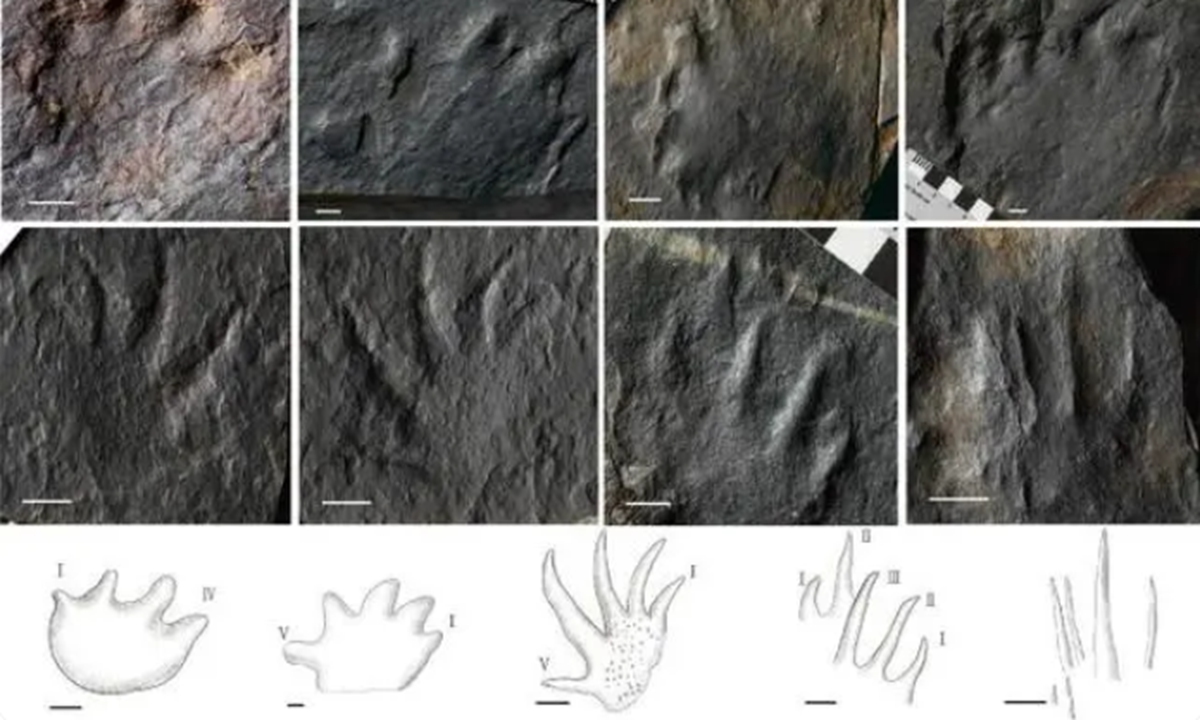
Photo: Screenshot
Chinese archaeologists on Friday announced the significant discovery of an early Permian tetrapod track assemblage known as the Mentougou fauna in the suburb of Beijing. Dating back approximately 300 million years, this discovery marks the earliest record of tetrapod fossils on the North China Plate.
The discovery was published in the National Science Review (NSR). It fills a critical gap in the early Permian tetrapod record in northern China and provides new insights into the connection between the North China Plate and Pangaea.
Chen Jianye, the first and co-corresponding author of the study, told the Global Times that since the inception of plate tectonics theory, terrestrial fossil records have been crucial in understanding the connections between landmasses. The fact that fauna specimens discovered on the North China Plate 300 million years ago are highly consistent with those on Pangaea indicates that they spread from Pangaea. This suggests that there was a passage between Pangaea and the North China Plate 300 million years ago that allowed animals to migrate freely.
"Typically, a single animal can complete transoceanic migration through rafting or ice age land bridges. However, for an entire group of animals, with individuals of various sizes, to complete transoceanic migration, the simplest and most likely explanation is that the North China Plate had already collided and merged with Pangaea," Chen explained.
This also supports the hypothesis that the North China Plate and the main body of Pangaea had already connected at the beginning of the Permian period, providing a new paleogeographic model for studying the tectonic history, paleobiology, and paleoclimate of the Late Paleozoic. Additionally, the Mentougou Fauna holds significant evolutionary importance as it includes the earliest record of amniotes in East Asia.
Amniotes are true terrestrial animals with reproduction independent of water environment. Their emergence and early evolution were closely linked to the formation of Pangaea. The earliest amniotes appeared around 320 million years ago on the western edge of Pangaea, resembling lizards, and rapidly diversified over the following 20 million years. By the early Permian, they had evolved into various carnivorous and herbivorous species, spreading across Pangaea.
The newly discovered Mentougou fauna includes tens of footprints of various shapes and sizes, identifying at least two major types of tetrapods of seven to eight different sizes and shapes. This assemblage represents the earliest known tetrapod fossils on the North China Plate.
During this period, terrestrial tetrapods were widespread across Pangaea with rich fossil records in present-day Europe, North America, and North Africa, but none confirmed in northern China until now.
Northern China lacks early records of amniotes until the middle Permian, about 30 million years later, the time of the diverse Dashankou Fauna discovered in Northwest China's Gansu Province. However, the evolutionary history of this fauna shows a significant gap. The Mentougou Fauna's amniote footprints are more primitive, likely left by early parareptiles or eureptiles, distinctly different from those of the Dashankou Fauna.
Chen explained that this footprint clearly differs from the morphology and abundance of amniotes of the Dashankou Fauna, thus suggesting the existence of "Olson's Extinction,"a mass extinction that occurred 273 million years ago in the late Cisuralian or early Guadalupian epoch of the Permian period.
In the future, the research team aims to search for tetrapod skeletal fossils in earlier strata. If such fossils are found, they will provide much more information than trace fossils.
"The discovery of footprints is just the beginning, and future discoveries will undoubtedly be even more exciting," Chen noted.




